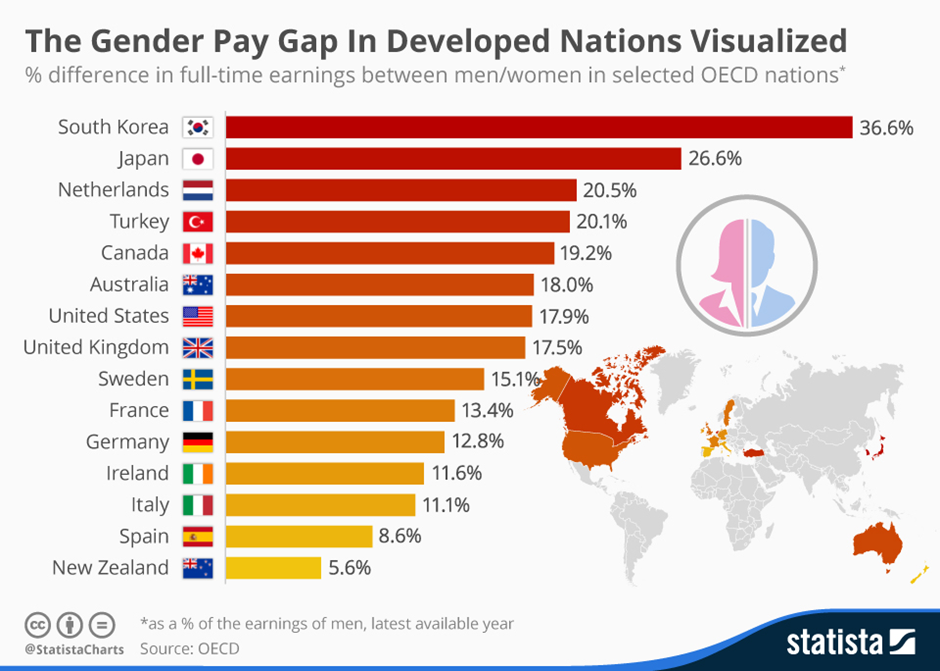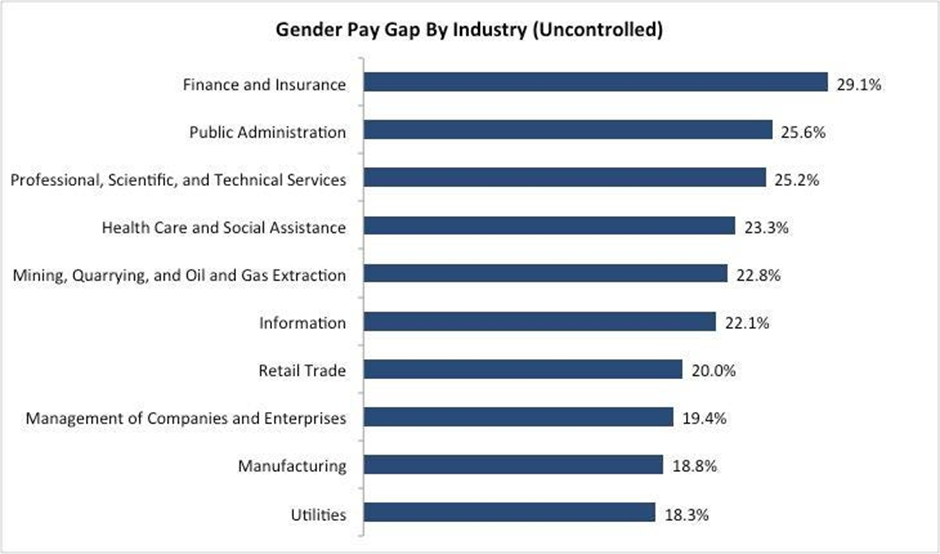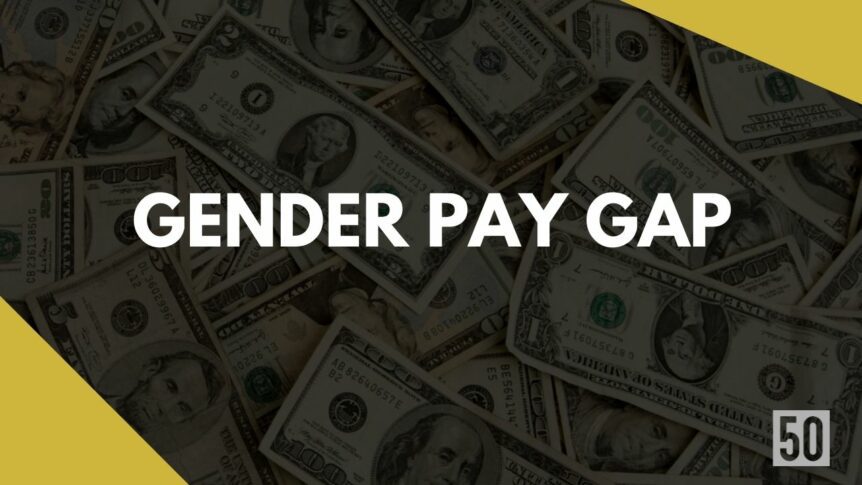Did you know that, on average, women are paid less than men for doing the same job? This is known as the gender pay gap. Despite initiatives to close this gap, it still exists in many countries around the world. In this blog post, we’ll look at some of the everyday effects of the gender pay gap. We’ll also explore some of the reasons why it persists. Finally, we’ll consider what can be done to reduce or eliminate it.
What Is the Gender Pay Gap?
The gender pay gap is a metric that calculates the mean figure of women and non-binary people’s pay against men’s pay in the same role or level. This disparity exists in almost every country in the world and is often attributed to women being devalued in the workforce, as well as a lack of flexible working arrangements and support for working mothers. While the gender pay gap has slowly been shrinking over time, progress has been slow, and there is still a long way to go before equality is achieved.
Why Is It Important For Businesses To Track Their Gender Pay Gap?
Gender pay gap reporting is an important part of understanding and addressing gender inequality in the workplace. It helps identify where women are being underpaid and why, so that businesses can take steps to eliminate it. The data also provides insight into how different factors like position, tenure, experience, etc., affect pay between men and women.
This information can be used to create more equitable pay scales and promote better job opportunities for women in the workforce. Tracking gender pay gaps can also help businesses with their recruitment, retention, and training policies, as well as showing their commitment to equality and diversity in the workplace.
By tracking their gender pay gap, businesses can improve employee morale, reduce staff turnover and increase productivity.
How Do You Calculate the Gender Pay Gap?
the gender pay gap is the difference in hourly earnings between men and women. In order to calculate the gender pay gap, you first need to add up the hourly rates for each gender. Then, you need to calculate the mean hourly rate for each gender by dividing the sum total of hourly rates by the total number of people in that gender group.
Finally, you need to take the mean hourly rate for men and subtract the mean hourly rate for women to get the pay difference for women. You can then convert that pay difference into a percentage to establish the Gender Pay Gap%.
If the Gender Pay Gap is large, an employer may choose to invest in training for women to help them advance their careers. Gender Pay Gap data can also be used to support lawsuits alleging discrimination in the workplace
What Factors Affect the Gender Pay Gap?
The gender pay gap is a serious issue in the workplace. While there are many factors that contribute to this discrepancy, some of the most significant include:
Industry:
Certain industries have a reputation for offering lower pay to women than men, such as financial services and technology. Women are also often excluded from these fields altogether, making them even more underpaid.
Education:
On average, women possess fewer educational qualifications than their male counterparts. This can lead to lower salary offers for women than men when applying for the same jobs.
Experience:
Even if two people have the same qualifications and work in the same field, women may find that they are offered lower salaries due to lack of experience in comparison to their male counterparts.
Discrimination:
Unfortunately, discrimination against female employees is still commonplace in many workplaces. This can take the form of lower pay, fewer benefits or less job security for women, leading to a wider gender pay gap.
Negotiation:
Men are more likely to negotiate for higher salaries than women, leading to a discrepancy in pay. Women may also be unable to leverage their experience in order to receive higher salaries.
Sociocultural factors:
Women are more likely than men to take time out of the workforce to raise children or care for a family member, leading to lost wages and fewer opportunities for career advancement. Additionally, gender stereotypes can lead employers to think that women are less capable than men, resulting in lower salaries for female employees.
These factors combine to create a gender pay gap in many businesses. As such, it’s essential for employers and employees alike to be aware of how these issues can affect the workplace, and work together to ensure that all workers are paid fair wages regardless of their gender. By doing so, we can help to reduce the gender pay gap and make businesses fairer for everyone.
Effects Of Gender Pay Gap On Businesses
The gender pay gap has been a long-standing issue in many businesses, and it has the potential to create significant negative impacts. Not only are women disproportionately affected, but businesses can also suffer if they don’t address the problem.
The most obvious problem that comes with gender pay gaps is loss of morale. Employees who feel that they are being paid unequally due to their gender can become disengaged and dissatisfied with the business. This could lead to decreased productivity as well as employees leaving for better opportunities elsewhere.
Gender pay gaps can also make it difficult to attract high-quality talent. When potential employees research a company, they usually take into account things like salary and benefits. If a company has a history of paying women less than men, it could discourage them from applying in the first place.
The gender pay gap can also damage a business’s reputation, as customers are becoming more socially conscious and want to support businesses that promote equality. Companies with known gender pay gaps can face public scrutiny and even boycotting, which can have a damaging effect on their bottom line.
Businesses need to recognize the impact of gender pay gaps and make changes to address it. It’s important that they don’t just focus on legal compliance but take action to ensure all employees are being paid fairly. This could include conducting an internal audit to identify any pay disparities and taking steps to rectify them. It’s also important that businesses create policies and standards to ensure gender pay gaps don’t occur in the future.
Ultimately, addressing gender pay gaps is not only the right thing to do but can help businesses be more successful in the long run.
What Is A Good Gender Pay Gap?
The gender pay gap is the difference between what men and women are paid for doing the same job. It is expressed as a percentage of men’s earnings. For example, if women earn £0.60 for every £1 that men earn, the gender pay gap is 40%. In the European Union, the average gender pay gap is 16%. The United Kingdom’s gender pay gap is 18%. The United States’ gender pay gap is even higher, at 21%.
A good gender pay gap is therefore one that narrows the divide between men’s and women’s earnings. This can be achieved through equal pay for equal work, and by tackling the root causes of occupational segregation and the undervaluation of women’s work. When the genders are paid equally for doing the same job, it results in more money in women’s pockets, which in turn stimulates economies and benefits society as a whole.
Benchmark Of Gender Pay Gap In Developed Nations
The gender pay gap is measured as the difference between male and female earnings as a percentage of male earnings, and it continues to be an issue in most developed countries around the world. Despite efforts to close this gap, it remains a major issue that needs to be addressed in order to ensure gender equality.
In 2016, male workers in South Korea earned 36.7 per cent more than female workers, making it the OECD country with the widest gender pay gap. Japan’s gender pay gap stands at 25.7 per cent while North American countries Canada and the United States have a wage gulf of 18.2 per cent. New Zealand has the narrowest gender pay gap of any OECD country, with male workers earning just 5.6 per cent more than their female colleagues.

Benchmark Of Gender Pay Gap Across Different Different Industries
It’s time we understand the true extent of the gender pay gap. PayScale, a salary information website, has released new data which reveals how pay disparities vary across industries, states and educational levels. Data was collected from 1.8 million employees between October 2014 and October 2016.
The overall gender wage gap reported by PayScale stands at 24%, two percentage points lower than last year and slightly higher than the 20% calculated by the Institute for Women’s Policy Research.

The following are the industries with the biggest pay gaps:
Strategies To Decrease the Gender Pay Gap
Increase salaries for women:
Companies should consider increasing salaries for women to help bridge the gender pay gap. This can be done by assessing employee performance, taking into account other factors like seniority, and providing competitive wages that reflect individual worth.
Eliminate biased hiring practices:
Unbiased hiring practices should be implemented to ensure that women are not held back in their careers due to gender. Companies should consider blind interviews and the use of numerical hiring criteria, such as education level or years of experience when making decisions on who they hire.
Provide mentorship opportunities:
Mentorship programs can help bridge the pay gap by providing women with guidance, resources, and support to help them advance their careers.
Increase transparency:
Companies should be transparent about wages and salaries, allowing employees to compare pay scales among peers doing the same job, regardless of gender. This can help reveal any potential discrepancies in compensation between men and women.
Encourage flexible work arrangements:
Flexible work arrangements such as telecommuting, remote work, and alternative schedules can help women balance work and family commitments. This can help make it easier for them to stay in the workforce, as well as advance their careers.
Provide leadership training:
Companies should offer leadership development programs that focus on helping women develop their professional skills and acquire new knowledge. These programs should focus on areas such as communication, problem-solving, and negotiation.
Offer paid family leave:
Paid family leave can help reduce the gender pay gap by allowing women to spend more time at home with their children, while still receiving income and support from their employers. This can help ensure that they don’t fall behind in the workplace due to taking a break from their career.
Create flexible career paths:
Companies should create more flexible career paths that allow women to take on different roles throughout their careers, instead of being pigeonholed into one role or job title. This can help them develop new skills while still advancing in the company.
Institute equal pay for equal work:
Companies should evaluate their compensation policies to make sure that men and women doing the same job are paid the same. They should also review all current and past salary histories to ensure that there is no discrepancy in wages between genders.
Educate employees about the gender pay gap:
Companies should provide training and educational opportunities to help employees recognize and understand the gender pay gap. This can help create a more informed and aware workplace environment, which can lead to better policies for addressing the issue.
By implementing these strategies, companies can make significant strides in bridging the gender pay gap. Taking action now will ensure that women are equally represented and valued in the workplace and that everyone can benefit from equal pay for equal work.
Conclusion
The businesses that are adapting to the changing landscape and increasing wages for women are seeing decreases in employee turnover rates and an increase in productivity. These companies are also attracting a more diverse pool of applicants, which can only be good for business. The gender pay gap is still a problem, but it’s one that businesses can help solve by taking intentional steps to create a level playing field for all employees.

